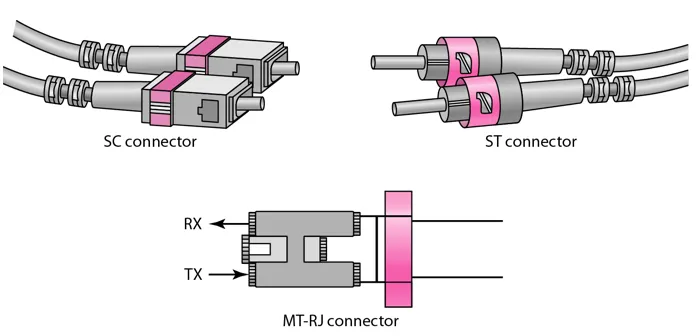
A fibre-optic cable is made of glass or plastic and transmits signals in the form of light.
For better understanding we first need to explore several aspects of the nature of light.
Light travels in a straight line as long as it is mobbing through a single uniform substance. If ray of light travelling through one substance suddenly enters another substance (of a different density), the ray changes direction.
The below figure shows how a ray of light changes direction when going from a more dense to a less dense substance.

Bending of a light ray
As the figure shows:
· If the angle of incidence I(the angle the ray makes with the line perpendicular to the interface between the two substances) is less than the critical angle, the ray refracts and moves closer to the surface.
· If the angle of incidence is greater than the critical angle, the ray reflects(makes a turn) and travels again in the denser substance.
· If the angle of incidence is equal to the critical angle, the ray refracts and moves parallel to the surface as shown.
Note: The critical angle is a property of the substance, and its value differs from one substance to another.
Optical fibres use reflection to guide light through a channel. A glass or plastic core is surrounded by a cladding of less dense glass or plastic. The difference in density of the two materials must be such that a beam of light moving through the core is reflected off the cladding instead of being refracted into it.

Internal view of an Optical fibre
Current technology supports two modes(Multimode and Single mode) for propagating light along optical channels, each requiring fibre with different physical characteristics. Multimode can be implemented in two forms: Step-index and Graded-index.

Multimode is so named because multiple beams from a light source move through the core in different paths. How these beams move within the cable depends on the structure of the core as shown in the below figure.

· In multimode step-index fibre, the density of the core remains constant from the centre to the edges. A beam of light moves through this constant density in a straight line until it reaches the interface of the core and the cladding.
The term step-index refers to the suddenness of this change, which contributes to the distortion of the signal as it passes through the fibre.
· In multimode graded-index fibre, this distortion gets decreases through the cable. The word index here refers to the index of refraction. This index of refraction is related to the density. A graded-index fibre, therefore, is one with varying densities. Density is highest at the centre of the core and decreases gradually to its lowest at the edge.
Single mode uses step-index fibre and a highly focused source of light that limits beams to a small range of angles, all close to the horizontal. The single-mode fibre itself is manufactured with a much smaller diameter than that of multimode fibre, and with substantially lower density.
The decrease in density results in a critical angle that is close enough to 90 degree to make the propagation of beams almost horizontal.
Optical fibres are defined by the ratio of the diameter or their core to the diameter of their cladding, both expressed in micrometers. The common sizes are shown in the figure below:

There are three types of connectors for fibre-optic cables, as shown in the figure below.

The Subscriber Channel(SC) connector is used for cable TV. It uses push/pull locking system. The Straight-Tip(ST) connector is used for connecting cable to the networking devices. MT-RJ is a connector that is the same size as RJ45.
Fibre optic has several advantages over metallic cable:
· Higher bandwidth
· Less signal attenuation
· Immunity to electromagnetic interference
· Resistance to corrosive materials
· Light weight
· Greater immunity to tapping
There are some disadvantages in the use of optical fibre:
· Installation and maintenance
· Unidirectional light propagation
· High Cost
Attenuation is flatter than in the case of twisted-pair cable and coaxial cable. The performance is such that we need fewer(actually one tenth as many) repeaters when we use the fibre-optic cable.
· Often found in backbone networks because its wide bandwidth is cost-effective.
· Some cable TV companies use a combination of optical fibre and coaxial cable thus creating a hybrid network.
· Local-area Networks such as 100Base-FX network and 1000Base-X also use fibre-optic cable.